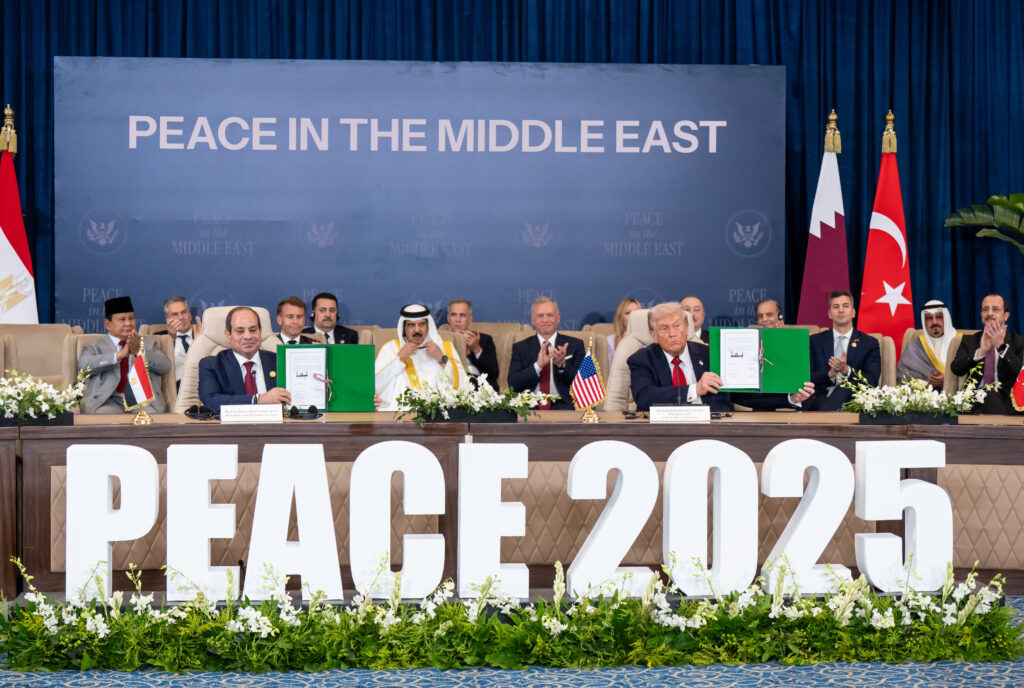Interviews / Middle East / North Africa
27 October 2025
The Trump Plan for Gaza: What Role and Position for the Arab States of the Middle East?

On 29 September 2025, Donald Trump unveiled a 20-point plan for peace in Gaza, suggesting the possibility of an end to hostilities two years after the attacks of 7 October and the start of Israel’s bombardment of the enclave. Yet, in a region where the word “peace” cannot simply be reduced to the mere silencing of weapons, this project raises questions. In January, the US president had already presented an initial plan aiming to turn Gaza into a “Riviera” and relocate Palestinian populations outside the enclave—a proposal unanimously rejected by neighbouring Arab countries. In what context of regional cooperation did this new initiative emerge? Have the Arab states of the Middle East played a role in it? And what is the current status of a potential international stabilisation force?
An update with Hadjar Aouardji, Director of Research at IRIS and Middle East specialist.
Did the Arab states of the Middle East contribute to the drafting of the Trump plan?
Although representatives from several regional states were invited to a meeting at the White House on 23 September, there is no evidence that they were genuinely involved in the development of this plan. Presented as a meeting between Trump and representatives of Muslim-majority countries, it was above all intended to legitimise the American president’s approach. Just hours after the plan was made public, the foreign ministers of eight states—Egypt, Jordan, Qatar, Saudi Arabia, the United Arab Emirates, Turkey, Indonesia and Pakistan—issued a joint statement reaffirming, among other points, the necessity of establishing a Palestinian state encompassing both the West Bank and Gaza.
Beyond Steve Witkoff, those who appear to have played a genuine role in drafting the plan are Jared Kushner, Tony Blair and Ron Dermer (Israel’s Minister of Strategic Affairs), who took part in a working meeting with Trump on 27 August. It is worth recalling that, in July, the Financial Times reported on a reconstruction plan for Gaza being developed by staff from the Tony Blair Institute for Global Change and the Boston Consulting Group, which had already been criticised for its activities linked to the Gaza Humanitarian Foundation.
To understand the reactions of Middle Eastern states to the 20-point plan, one must look back to the first Trump plan, announced at the end of January 2025, which envisioned rebuilding a “Riviera” and emptying Gaza of its Palestinian inhabitants. This proposal shocked Egypt and Jordan in particular, as both were expected to receive displaced Palestinians. Beyond the risk of ethnic cleansing, such a plan was inconceivable for Jordan—where around 70% of the population is of Palestinian origin—as it effectively embodied the Israeli thesis that the Hashemite Kingdom constitutes the de facto Palestinian state (the so-called “alternative homeland”, al-Watan al-Badîl). Egypt, too, firmly opposed the plan for both security (the Sinai had been the centre of an insurgency for nearly a decade) and economic reasons (according to Egypt’s Central Bank, Suez Canal revenues have dropped by 45.5% this year). Moreover, since April 2023, Egypt has hosted between 600,000 and 1.5 million Sudanese refugees. Faced with resistance from Cairo and Amman, Washington went so far as to threaten to suspend American economic aid.
It was in this context that Egyptian diplomacy mobilised to propose an alternative plan, which—although endorsed by the Arab League in March 2025 and supported by France, Germany, Italy and the United Kingdom—was almost immediately rejected by Washington and Tel Aviv. This plan laid out a detailed roadmap for Gaza’s reconstruction: a three-phase, five-year project estimated at $53 billion. Meanwhile, the Emirati ambassador to the United States, Yousef al-Otaiba, declared that there was “no alternative” to Trump’s first plan—revealing, once again, the absence of a common Arab position.
Ultimately, the “Riviera project” functioned as an Overton window: it is therefore unsurprising that Amman and Cairo so swiftly endorsed the new 20-point plan.
However, the ceasefire remains fragile…
Indeed, it remains extremely fragile. Although Trump has triumphantly proclaimed “peace in the Middle East”, we are still far from that reality. One of the major risks is that, once the bodies of all hostages are recovered—or, conversely, if they are not—Prime Minister Benjamin Netanyahu, under pressure from the most extremist factions of his government, might resume military operations. On Sunday, 19 October, Israel dropped 153 tonnes of bombs on Gaza, officially in response to attacks by Hamas, which the group has firmly denied. This came perilously close to breaking a ceasefire that was less than ten days old.
We have also witnessed a reassertion of Hamas’s control over security, as the organisation has returned to public spaces—demonstrating that its forces have not been significantly weakened and that it continues to control Gaza (more precisely, 47% of the territory not under Israeli military control). Images have circulated showing summary executions of individuals accused of collaborating with Israel. On 12 October, Trump declared: “They really want to put an end to the problems, and they have said so openly. We have granted them authorisation for a certain period.” Six days later, the White House issued a statement urging Hamas to cease such violence.
Several factions and clans have expanded their influence across different parts of Gaza. Some, notably members of the Doghmush clan, have been accused of collaborating with Israel and participating in the killings of Palestinians as they queued for humanitarian aid, or looting aid trucks. These executions also appear linked to the killing, on 10 October, of Muhammad Imad Aqel—the son of a senior member of the al-Qassam Brigades—by members of this clan. Two days later, they kidnapped, tortured and killed Salah al-Jaafarawi, a prominent Palestinian journalist widely followed on social media.
Another notable family is the al-Majayda clan. During violent clashes between its members and Hamas earlier this month, Israel bombed the area, killing around twenty Hamas fighters. The strike was consequently perceived as evidence of Israeli support for the clan. Other groups or militias are also reported to operate in coordination with Israeli forces within the occupied zone—among them those led by Yasser Abu Shabab, Rami Halas, Hossam al-Astal, and Ashraf al-Mansi. Clearly, the situation remains highly volatile; the disarmament phase could drastically reshape power dynamics on the ground.
The Trump plan refers to the establishment of an international stabilisation force: what is the current state of this initiative?
Interestingly, the idea is not new. According to the Egyptian online outlet Mada Masr, citing an official Egyptian source, just weeks after 7 October 2023, Tony Blair, Jared Kushner, Ron Dermer and Mohamed Dahlan—a Palestinian dissident protected by the United Arab Emirates—met in Abu Dhabi to explore post-conflict scenarios. It was during this meeting that the idea of a joint Arab force aimed at protecting Israel is said to have emerged. This proposal was reportedly presented to Amman and Cairo as originating from the United States. Following these initial discussions, certain Arab states are believed to have requested that the US assume security control over Gaza—on the condition that Egypt, Jordan, the UAE, Morocco and Indonesia would also contribute. It is noteworthy that even before Donald Trump’s return to the White House, the United States was already expected to play a leading role in post-conflict governance. The 20-point “Trump Plan” unveiled in late September owes much to these earlier behind-the-scenes negotiations… conducted under Joe Biden.
On 17 October, the US Central Command (CENTCOM) opened a Civil-Military Coordination Centre (CMCC) in Kiryat Gat, southern Israel. Two hundred American soldiers are already deployed there, with British troops set to join the mission, and France having already sent three servicemen. The question now is which regional states will contribute troops. An investigation published on 11 October by the International Consortium of Investigative Journalists (ICIJ) offers clues: it revealed that between 2022 and 2025, six Arab states—Qatar, Bahrain, Egypt, Jordan, Saudi Arabia and the UAE—secretly engaged in military cooperation with Israel under US supervision. It is therefore likely that some of these countries will take part in the stabilisation force. Indonesia, Azerbaijan and Pakistan are also mentioned as potential contributors. Meanwhile, Turkey—though formally a guarantor of the ceasefire—has seen its participation firmly rejected by Tel Aviv.

